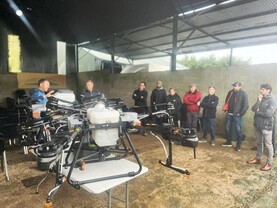An awkward week: The past week has been a bit tricky in terms of getting work done due to showers and wind at times. This made spraying awkward, even when it was not wet.
Crops remain generally clean with a few exceptions, but it seems inevitable that we will see more wet season diseases appear shortly. Still, we must hope that timely fungicides will keep them at bay. Septoria is making a bit of a resurgence in parts of the country, but hopefully fungicides will do their job to help keep it and other diseases away.
Winter crops: All wheat crops will have received their T2 fungicide by now and many crops are already earing/eared out – some are even flowering. This will mean that it will be time for head sprays shortly.
This will normally mean a mix of two triazoles for the final spray, to help contain the ear blight complex. Target the T3 to crop flowering rather than just at the eared out stage. There may still be a long way to go to the end of grain fill. The mid-flowering timing is also regarded as the best stage to maximise fungicide efficacy against the ear blight complex.
All barley crops should now have completed a fungicide programme and ideally are now in grain fill. Keep an eye on them in case brown rust or rhyncho get a grip. Oat crops are largely headed out and should have their final fungicide.
Spring crops: Growth has been good over the past few weeks, with crops varying from early stem extension to flag leaves appearing – some have patches of awns showing. Most crops remain clean and hopefully they will stay that way.
There is a bit of virus evident in some crops. The foliar disease situation could change following the showery weather and rhyncho is always about. Net blotch remains a challenge in some crops of Planet.
All spring barley is likely to have received at least one fungicide at this stage, so these crops should be protected for a few weeks.
Crops that were sprayed a few weeks ago will need their second and final spray once we get beyond the paint brush stage. Include a strong dose of folpet in the final spray, as ramularia is evident in the winter crops.
Early oat crops are coming up to flag leaf emerging, with later crops not too far behind. Further growth regulation is advisable on oats, especially in strong ground, as the bulk of the overall length happens post-flag leaf emerging. Shortening is always more effective when applied during longer internode lengths and when growth is active. Options for this timing include Ceraide, Moddus or Medax Max.
Forward contracts: It seems that the upward march in forward contract prices has ceased for the time being. MATIF December wheat prices dropped €50/t from peak recently, a reminder of the fragility of the market.
Forward sales are important in the grain sector and deals already done indicate a trust between sellers and buyers, which is important for all businesses.






 This is a subscriber-only article
This is a subscriber-only article










SHARING OPTIONS: